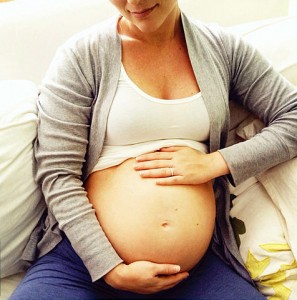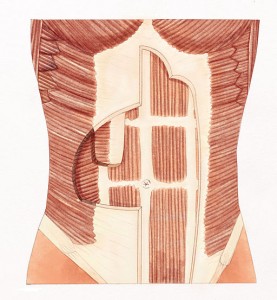Diastasis recti is a separation of the abdominal muscles. The most superficial abdominal muscles are the abdominis rectus. The abdominis rectus is formed by two strips of muscle, that run parallel to each other, down the center of the abdomen. They are connected by a strip of connective tissue called the linea alba.
Some people are born with diastasis recti however, this separation of the abdominal muscles is also a common side effect of pregnancy. The pressure of a growing baby and can cause the mother’s abdominsis rectus to separate. After delivery the diastasis recti will often go away on its own.
However, studies have indicated that as many as two thirds of pregnant women have a postpartum diastasis recti. The risk of having a postpartum diastatis recti is increased by:
- Poor posture

- excessive weight gain during pregnancy
- inactivity during pregnancy
- performing inappropriate abdominal exercises during pregnancy
- multiple pregnancies
The Journal of Women’s Health Physical Therapy published a study in 2005 found that women who are physically active during pregnancy are less likely to have a diastasis recti. In fact, the study found that 90% of physically inactive women had a diastasis recti while only 12.8% of active women had one.
Pregnant women who want to use exercise as a way of preventing a diastasis recti should be careful to avoid abdominal exercises that could encourage the separation of the abdominis rectus. Popular exercises like planks and crunches are not good choices for pregnant women. During pregnancy women should focus on exercises that strength the transfer abdominis muscle which is located deep within the abdominal core.
This core contraction exercise would be a good choice for pregnant women.
Seated Core Contraction Exercise
- In a seated position, place both hands on abdominal muscles.
- Slowly contract the abdominal muscles, pulling them straight back towards the spine.
- Hold the contraction for 30 seconds, while maintaining the controlled breathing.
- Complete 10 repetitions.
Women that have a postpartum diastasis recti can reduce separation and protect themselves against further complications by doing exercises that will enhance deep abdominal strength.
Postpartum diastasis recti exercises
Heel drop with a core contraction
- Lay on the ground, face up with your knees bent,
- feet flexed and heels on the ground.
- Exhale through your nose, emptying your lungs of air, feel the connection deep in your core and pelvic floor. Do not suck in your tummy or tuck in your butt.
- Lift one leg toward the chest, than drop the heel back to the ground.
- Inhale and relax the core.
- Repeat 5 times on each side.
Foot slide with core activation
- Lay on the ground, face up, with your knees bent and feet on the ground.
- Exhale through your nose, emptying your lungs of air, feel the connection deep in your core and pelvic floor. Do not suck in your tummy or tuck in your butt.
- As you exhale slide one foot along the floor by extending the leg.
- Inhale and relax the core
- Exhale engage the core once more and draw the leg back up to the bent position.
- Repeat 5 times on each side.
Wall squat
- Stand with back against the wall, feet out in front of body,
- Slide your back down the will and slowly lower body to a seated position so knees are bent at a 90° angle.
- Contract the abs toward spine as you raise body back to standing position.
- Optionally, this exercise can also be done using an exercise ball placed between the wall and your lower back.
- Complete 20 Repetitions.






